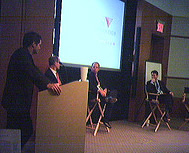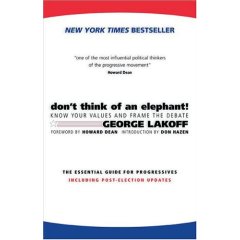 Did Johnson & Johnson heed my advice to stay away from purchasing Guidant with its unethical practices? Probably not, but I’m glad they’re hesistating. Guidant responds, typically, by suing the company that wants to buy it.
Did Johnson & Johnson heed my advice to stay away from purchasing Guidant with its unethical practices? Probably not, but I’m glad they’re hesistating. Guidant responds, typically, by suing the company that wants to buy it.
Category: Design
-
Guidant shakes with one hand and serves a lawsuit with the other
-
500 years later, da Vinci’s bridge is constructed in Norway

A story of classic inspiration…
Norwegian painter and public art creator, Vebjørn Sand, saw the drawing and a model of the bridge in an exhibition on da Vinci’s architectural & engineering designs in 1996. The power of the simple design overwhelmed him. He conceived of a project to bring its eternal beauty to life. The Norwegian Leonardo Bridge Project makes history as the first of Leonardo’s civil engineering designs to be constructed for public use.
-
Fairly Good Practices
Fairly Good Practices from the Agile community (of which the design and management communities can learn a lot).
-
Cultural capabilities: JetBlue vs. Song
Song Airlines is closing. It’s sad that a better customer experience alone isn’t enough to compete, but that in itself is a good lesson. The symptom of Song’s decline was a failure to replicate JetBlue’s service, while the cause is a failure to look beyond JetBlue’s product to the true source of their success. There’s a relationship between product, process, and culture, and JetBlue’s employee-focused (not consumer-focused!) culture is what propels them.
Though I must say the popular doubts about JetBlue’s ability to preserve this culture while they grow and grow are substantiated. As a JetBlue customer, I don’t feel the experience is any better these days, I only fly them for the price. It’s time for change.
-
Bootstrap 1.0
In response to David Hornik’s Bubble 2.0 I responded that it looks more like Bootstrap 1.0 to me. Scott blogged this topic a month ago…
With customers using a working product, decisions about what type of additional capital will be needed to scale are much easier to frame. And if you do decide to approach an outside investor, you’ll be holding more of the cards. …Bootstrapping is the new black.
I think we’ll see more overall innovation in the world if smart people aren’t only spending their time at investor presentations, waiting with their hands out instead of getting down to work.
It could be more profitable too. Today’s Wall Street Journal covers the topic, reporting the amount Flickr received from Yahoo! ($25 million?) was “significantly higher than the value Accel Partners had put on the company and Accel’s proposed investment.”
There’s still a place for venture investment of course. But VCs might need to evolve, making a greater number of smaller investments.
And incidentally, how funny is it to see the name Ludicorp in the Wall Street Journal?
-
Mintzberg and Liedtka think it’s time for design
In Mintzberg’s “Strategy Safari” he devotes one chapter to The Design School: Strategy Formation as a Process of Conception. But his description of the cognitive act of design is different from the classic Herbert Simon description. So I appreciated discovering Liedtka’s In Defense of Strategy as Design (pdf), summarized…
This article proposes management reconsider the usefulness of the metaphor of design as a prescription for strategy making, arguing against Henry Mintzberg’s view that it is not appropriate. It reviews literature from the field of design and defines a set of attributes of the design process – which is synthetic, abductive, hypothesis-driven, opportunistic, dialectical, inquiring, and value-driven. The article examines the parallels between designing and creating business strategy and presents the implications of such an approach for designing the processes to design and execute strategy.
(Her Strategy as Design (2MB pdf) is an updated version of this argument.)
Now it seems Mintzberg and Liedtka have joined forces, submitting a piece titled Time for Design, “…making the case for design in management, in four approaches: formulaic, visionary, conversational, and evolving.” I’m looking forward to this one.
-
ID Strategy Symposium and the design-business chasm

Yesterday I attended the Institute of Design Strategy Symposium. The remarks were along the lines of business design we’ve been reading about. What I particularly liked was that the conversation afterwards revolved mostly around the chasm between design and business and the means by which to span the chasm, mostly in terms of language (“design” is a non-starter; “innovation” is more business-friendly but too ambiguous to do anything more than start the conversation).
My colleagues and I don’t buy the stereotype of creative designers vs. logical financial people. There are people with different skillsets and attitudes and the best way to combine them to design new options is through close collaboration (aka co-creation). The example from the Symposium came from Mike Roberts who runs a customer experience group at JP Morgan. He makes progress through direct, personal conversations with people in traditional financial roles. As my friend Bill says, “Collaboration problems are People problems. They are often best solved by increasing the communication bandwidth between people.” The next step, I think, is to work on the best ways to get these skillsets collaborating using modes of conversation, prototyping exercises, boundary objects, and so on.
-
Worse is better (and more human-centered)
Nicholas Carr’s argument against peer-production of knowledge by “amateurs” has been getting a lot of attention, but I think it misses the point.
It’s not human-centered. I don’t mean that in a make the interface easy to use kind of way, but in a make it something people want kind of way. For example:
- We’re still learning that worse is better. In many cases simplicity is more important than correctness, consistency, and completeness. This is the reason Unix won out over Lisp (and then Linux over Unix), and more people read Wikipedia than Encyclopedia Brittanica. Most of the time a fast and free resource will suffice. It’s what people want.
- The algorithm that creates MP3s can make files smaller because it reproduces only the sound that humans hear and discards the rest, instead of trying to keep all the sound the microphone hears. MP3s won out over audiophile options because people like having 10,000 songs in their pocket. Most of the time a fast and free resource will suffice. It’s what people want.
Besides, these products don’t stay “worse” forever. They start simple, gain “market share” in a disruptive way, and then are improved over time. Linux has improved considerably. Wikipedia gets better every minute. AAC is an improvement over MP3. The new breed of wikis look swanky compared to the original wikis.
The ability to launch something simple and improve it over time is a huge competitive advantage for companies like Google. Can you imagine an established company having the discipline to launch something as simple as Craigslist?
The mantra is Do The Simplest Thing That Could Possibly Work.
-
The listening-to-customers wake up call
Looking back through the classic management texts I realize the call to listen to customers isn’t new. Here’s a few that counsel an emphasis on customers:
- Innovation in Marketing (1962)
- In Search of Excellence (1982)
- Moments of Truth (1987)
- Relationship Marketing (1991)
- The Experience Economy (1999)
The repetition of this message isn’t surprising as it’s easy to walk around a modern corporation and meet plenty of people who should be familiar with their customers but aren’t. My little wake up call consists of asking, “How many of your customers have you met?” even when I know the answer is “none.”
-
Steve Jobs and the parable of the concept car
 We thought a lot about concept cars last year and how we could translate this practice to other industries. So it’s fun fun fun to hear the latest Steve Jobs metaphor…
We thought a lot about concept cars last year and how we could translate this practice to other industries. So it’s fun fun fun to hear the latest Steve Jobs metaphor…You know how you see a show car, and it’s really cool, and then four years later you see the production car, and it sucks? And you go, What happened? They had it! They had it in the palm of their hands! …What happened was, the designers came up with this really great idea. Then they take it to the engineers, and the engineers go, ‘Nah, we can’t do that. That’s impossible.’ And so it gets a lot worse. Then they take it to the manufacturing people, and they go, ‘We can’t build that!’ And it gets a lot worse.”
Of and course, he counters that with a “No, no, we’re doing this…Because I’m the CEO, and I think it can be done.” It’s good to be the king.
Link courtesy of G-Bomb.
-
A challenge to the design thinking/business design community
A recent post from Jess inspired several interesting comments about who designers are really, and how to gauge the maturity of an organization’s design. Unless you really like thinking about this topic, it must seem like an awful lot of navel gazing, which is fine as that’s one thing that makes blogs useful to us: debating half-formed thoughts.
But for me — someone who wants to make an impact on my clients welfare — Jess gets to the heart of the matter when he says, “I don’t know that the term “design thinking†will actually make an impact in the boardroom…” Although I explicitly talk about design thinking on this blog, I don’t think this term will impact the boardroom, at least not directly and not in the short term. It’s esoteric, too easily confused with style/form/function, and suffers from navel gazing. It’s what we do using design thinking that will impact the boardroom. The benefits as a concept are already understood, and to activate that concept in executives’ minds — and for the community to make substantial progress — we must frame the idea of design thinking differently.
No one has framed it well yet, because we’re still discovering it. But perhaps we’re now ready to move forward.
My challenge to the community is to reframe design thinking / business design in a way that will impact the boardroom.
Here’s how I would start framing it…
- The pace and complexity of 21st century society present formidable challenges that require us to compliment our judgement thinking with an additional way of thinking which is collaborative, abductive, experimental, personal, integrative, and interpretive (replace with your own definition)
- This way of thinking leads us to do (fill in kinds of actions)
- These actions benefit companies by (fill in kinds of benefits in a way that impacts profit)
- The above can be summed up by saying, “(fill in summary in ten words or less)”
That summary is the frame.
(We could get very meta and apply design thinking to this problem, which I’ll leave as an exercise for the reader).
-
Tim Brown on design thinking
Organizations need to take design thinking seriously. We need to spend more time making people conscious of design thinking — not because design is wondrous or magical, but simply because by focusing on it, we’ll make it better. And that’s an imperative for any business, because design thinking is indisputably a catalyst for innovation productivity. That is, it can increase the rate at which you generate good ideas and bring them to market. Where you innovate, how you innovate, and what you innovate are design problems. When you bring design thinking into that strategic discussion, you join a powerful tool with the purpose of the entire endeavor, which is to grow.
More: Strategy by Design
-
JetBlue and outsourcing
 Bruce Nussbaum (on his new blog, congratulations Bruce!) argues that JetBlue has pushed prices down through smart operations while avoiding outsourcing. While I agree, one could say CEO Neeleman has been outsourcing in an innovative way for years, by not housing a call center and instead “homesourcing” this function to individuals’ homes. The cost advantages come from relocating the employees geographically and lowering overhead, the same as if he sent the function to India (but without the political backlash).
Bruce Nussbaum (on his new blog, congratulations Bruce!) argues that JetBlue has pushed prices down through smart operations while avoiding outsourcing. While I agree, one could say CEO Neeleman has been outsourcing in an innovative way for years, by not housing a call center and instead “homesourcing” this function to individuals’ homes. The cost advantages come from relocating the employees geographically and lowering overhead, the same as if he sent the function to India (but without the political backlash).I don’t know how Neeleman arrived at this idea, but this is just the kind of solution I think can come from good decision design, of creatively generating further ideas in the face of convention to arrive at new and better options.
-
Reframing control in social media
We’ve been working for several companies facing how they and their markets change with the further spread of social media. It’s creating enormous potential for more democratic media production and sophisticated tools, but a lot of it will rely on companies understanding it and being receptive to it. We’re developing a framework to help companies do this, and one of the key considerations is not scaring the shit out of them.
I’m referring here to the control issue. Some have simply said “you must give up control.” J.D. Lasica puts it more gently: “We’re transitioning to a new kind of culture. More participatory, more open, more interactive where the locus of control passes.â€
I agree, and yet telling business people they’re losing control isn’t likely to go down well. People like control. Managers like control. Control helps us survive in an uncertain world.
Jeff Jarvis frames it a different way: “The No. 1 lesson of the Internet whether you’re Howard Dean or a media company or a marketer, is that you have to give up control to gain control.” He cites a benefit, but still we’re left asking, “How much control does one give up? What do we really stand to gain?” Business managers aren’t an audience of socialists, they’re an audience that needs to make money to keep themselves and their colleagues employed in an uncertain economy.
 I think frames that appeal to good old fashioned business drivers will be more effective, such as:
I think frames that appeal to good old fashioned business drivers will be more effective, such as:- build communities of loyal customers
- reduce content creation/acquisition costs
- increase audience size through viral marketing
- offensively compete with would-be disruptive media forces
…and so on. We outlined these in the form of a poster, Social Media and Value Creation. It’s a work in progress; we haven’t seen established companies pursue this course yet and everyone will be learning.
-
Don’t Think of an Elephant!
 I finally got a around to reading Don’t Think of an Elephant! in which George Lakoff applies his linguistic and cognitive ideas on framing to American progressive politics. It’s a compelling, important book, and the theory can be used anywhere, particularly the hierarchy of vision -> values -> principles -> policies -> ten-word philosophy. It’s also short, there’s no excuse not to read it.
I finally got a around to reading Don’t Think of an Elephant! in which George Lakoff applies his linguistic and cognitive ideas on framing to American progressive politics. It’s a compelling, important book, and the theory can be used anywhere, particularly the hierarchy of vision -> values -> principles -> policies -> ten-word philosophy. It’s also short, there’s no excuse not to read it.— — — — —
My running notes…
Reverse engineer the conservative phrases: Bush said, “We don’t need a permission slip to defend America.” This invokes the parent-child relationship; we understand large social groups in terms of small ones. He specifically used the strict father frame (see James Dobson‘s Dare to Discipline). Essentially it is a father who can
- Protect the family in a dangerous world
- Support the family in a difficult world
- Teach his children right from wrong
This leads directly to the morality of self-interest and Adam Smith’s free market capitalism.
Progressives have a nurturant parent model that is gender neutral and assumes children and the world is a good place, and our job is to make it better. The values are
- freedom
- opportunity
- prosperity
- fairness
- open, two-way communication
- community-building
The conservatives have factions, but they found their common interests and invested in institutes and think tanks, which paid off in media exposure.
The progressive Enlightenment emphasizes truth, but the truth must be presented in way that fits people’s frames. Concepts are instantiated as synapses in our brains, and facts that don’t fit aren’t strong enough to create new structures.
Self-interest forms the basis of conservative values, but doesn’t act on the surface. People will vote against the candidate who gives them tax cuts if they identify with the values of the other candidate, even if that’s a worse choice for them personally.
Tailoring issues to polls can be useful, but the conservatives real method is to say what they idealistically believe, they talk to their base using the frames of the base. The undecided in the middle have multiple frames present, and you can activate one with your language. Clinton’s “welfare reform” and “the age of big government is over” did this by stealing the enemy’s language.
Taken further it becomes Orwellian — opposite — like Clear Skies and Healthy Forests. It signals where they are pushing unpopular initiatives and are vulnerable. See Frank Luntz. Deceptive frame is morally reprehensible and eventually backfires.
But the words must follow from ideas. The idea, the frame, is already is people’s minds. If it isn’t, you suffer from hypocognition, the lack of a needed concept.
(It occurred to me while visiting Germany that Germans don’t mind paying their high taxes because it’s a great value; they get awesome service for their tax dollar. I think Americans are used to a certain level of service and figure taxes will go up without a corresponding increase in service. Could service level in the business sense be used in government?)
Progressives are often on the defensive because the conservatives are better funded. Progressives fund grassroots, conservatives fund infrastructure. The right cuts taxes, the left helps the poor, and the right privatizes the left.
Solution: talk about values. See the Rockridge Institute.
Strategic conservative initiatives attack at the root: tax cuts disable many social programs, tort reform disables many environmental lawsuits (and subsequently cuts donor money from Democrats).
Strategic initiatives can start as slippery slope issues: Intelligent design, partial-birth abortion…
Hierarchy of action: identify your moral values, generate political ideas, invest in infrastructure, frame those ideas in language.
The media requires stories, and stories require frames.
Voters vote based on their identity: who they are, what values they have, and who and what they admire, more so than based on self-interest.
Some Conservatives are better named radical right-wingers.
Schwarzenegger = stereotypical strict father. He used a Voter Revolt frame, which turned around is a Right Wing Power Grab frame, claiming to represent the people while leveraging the resources of the Republican infrastructure.
When you understand the strict father model, you understand how gay marriage is such a threat to everything conservative. Arguing for gay marriage must go beyond the pragmatic benefits of marriage, the frame “freedom to marry” evokes the American ideals open to all. It’s about equal rights and having a state that provides them. Appeal to sanctity rather than basic economic fairness.
To extend the strict father metaphor to war, anything you do against the evil side is good, whereas progressives would view certain actions as evil even if they’re used to battle evil people.
Addressing the culture of despair suffered by Islamic communities in the middle east might make them more willing to take more moderate positions towards American culture and other elements they object to.
Nixon’s “I am not a crook” illustrates that the use of negatives frames the situation the wrong way, we must use positive language.
Applied to foreign policy:
- Values: fairness, minimal violence, an ethic of care, protection for those needing it, a recognition of interdependence, cooperation for the common good, the building of community, mutual respect…
- Concerns: environment, women’s rights…
- Actions: Anti-Ballistic Missile Treaty, Kyoto accords…
…if foreign policy doesn’t follow from moral norms, contradictions arise, such as being anti-terrorism while ignoring terrorism of Russians and Pakistanis or sponsoring terrorists ourselves.
A perpetual state of war contributes to the conservative agenda by sapping money from social programs (and not raising taxes).
Lies, in the case of President Bush’s reasons for going to war, can be explained in terms of exaggerations, misleading statements, mistakes, rhetorical excesses… A lie may only be a lie if that person didn’t believe what was said. And ultimately lies are minor compared to the betrayal of trust.
Wedge issues: guns, babies, taxes, same-sex marriage, the flag, school prayer.
“Ten word philosophy” with my modifications:
Strong economy
Prosperity for all
Better education
Effective Government
Mutual responsibilityAlways start with values, values everyone shares.
Use rhetorical questions: “Wouldn’t it be better if…”
Show moral outrage with controlled passion.
Always be on the offense. Don’t negate the other person’s claims; reframe. Never answer a question framed from your opponents point of view.
Tell a story where your frame is built into the story.
Use wedge issues: “Do you support a Military Rape Treatment Act to allow our raped women soldiers to be treated in military hospitals to end their rape-induced pregnancies?”